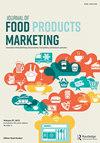Southeast Brazilian Consumers’ Involvement and Willingness to Pay for Quality Cues in Fresh and Cooked Beef
IF 2.4
Q2 BUSINESS
引用次数: 2
Abstract
ABSTRACT This study evaluates consumer Willingness-to-Pay (WTP) according to preferences for quality-cue attributes offered in two different purchase modes: fresh and cooked meat. The questionnaire was applied and answered by 534 Brazilian meat consumers. Three clusters were defined: Group 1- price conscious consumers; Group 2- quality cues conscious consumers; and Group 3- consumers who were neither price nor quality cues conscious. Different levels of consumer involvement are related to different levels of a purchase intention regarding breed and flavor. Using a logit regression model, the probabilities regarding individual choice and WTP were then calculated. Results indicate significant differences (p < .01) between attributes and for both fresh and cooked beef. For fresh meat, the most important quality cue was its bright red color and the least important its marbling. Interestingly, the lowest product price level does not appear to motivate purchase intention. For cooked beef purchase, consumers highly valued tender meat with flavor and aroma. When a consumer evaluates the purchase of fresh meat, WTP starts at a low level, and then increases with the introduction of positive quality-cue attributes. The opposite is true for cooked meat, where WTP starts at a high level and then decreases as negative quality cues are introduced.巴西东南部消费者对新鲜和煮熟牛肉优质Cues的参与度和支付意愿
摘要本研究根据消费者在两种不同的购买模式(鲜肉和熟肉)下对质量线索属性的偏好来评估消费者的支付意愿。534名巴西肉类消费者应用并回答了该问卷。定义了三个集群:第一组——注重价格的消费者;第2组-有质量线索意识的消费者;第3组——既没有价格意识也没有质量意识的消费者。不同程度的消费者参与与关于品种和风味的不同程度的购买意图有关。使用logit回归模型,计算了个人选择和WTP的概率。结果表明,新鲜牛肉和煮熟牛肉的属性之间存在显著差异(p<0.01)。对于鲜肉来说,最重要的品质线索是它的鲜红色,而最不重要的是它的大理石花纹。有趣的是,最低的产品价格水平似乎并不能激发购买意愿。在购买熟牛肉时,消费者非常重视有风味和香气的嫩肉。当消费者评估新鲜肉类的购买时,WTP从低水平开始,然后随着积极质量线索属性的引入而增加。熟肉的情况正好相反,WTP从高水平开始,然后随着负面质量线索的引入而降低。
本文章由计算机程序翻译,如有差异,请以英文原文为准。
求助全文
约1分钟内获得全文
求助全文
来源期刊

Journal of Food Products Marketing
BUSINESS-
CiteScore
5.70
自引率
6.90%
发文量
17
期刊介绍:
From food promotion and advertising through new food product development and consumer behavior research, the Journal of Food Products Marketing provides timely, practical articles that keep food marketers on the cutting edge of their profession. The journal includes refereed research studies as well as opinions, guidelines, and speeches by practitioners that contribute to the better practice and understanding of food marketing. The journal provides a single forum for both food marketing academicians and food marketing practitioners.
 求助内容:
求助内容: 应助结果提醒方式:
应助结果提醒方式:


